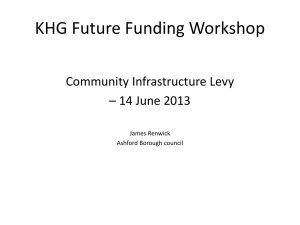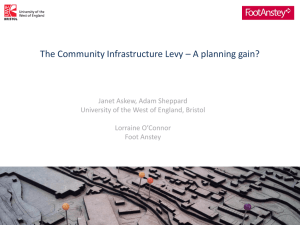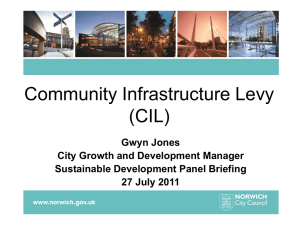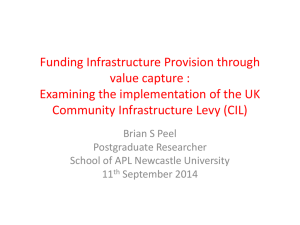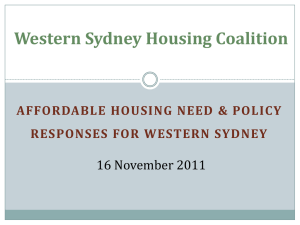CIL and section 106 Statement
advertisement
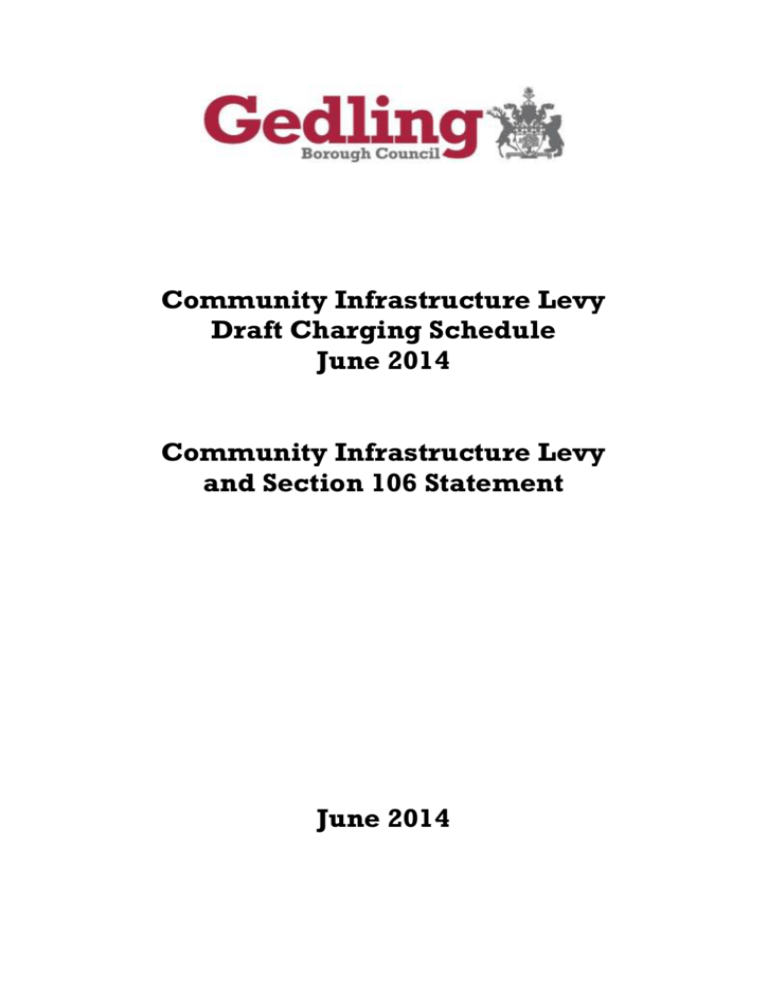
Community Infrastructure Levy Draft Charging Schedule June 2014 Community Infrastructure Levy and Section 106 Statement June 2014 1. Introduction 1.1 This document explains how Community Infrastructure Levy (CIL) and Section 106 will be used together to deliver planning obligations and to demonstrate that developers will not be required to pay twice for the provision of infrastructure, through both a CIL charge and a Section 106 contribution. A clear and transparent system is necessary for identifying what infrastructure will be funded through CIL and in what circumstances infrastructure would be required in addition to the CIL payment as a planning obligation. 1.2 Paragraph 206 of the National Planning Policy Framework (NPPF)1 states that planning conditions should only be imposed where they are necessary, relevant and reasonable in all other respects. Planning obligations should only be used where it is not possible to address unacceptable impacts through a planning condition and where they meet the three tests set out in CIL Regulation 122 and paragraph 204 of the NPPF: ‘A planning obligation may only constitute a reason for granting planning permission for the development if the obligation is – a) necessary to make the development acceptable in planning terms; b) directly related to the development; and c) fairly and reasonably related in scale and kind to the development.’ 2. Community Infrastructure Levy and Section 106 2.1 After 6 April 2015, or on adoption of CIL (whichever is earlier), Gedling Borough Council will only be able to pool up to five Section 106 contributions towards the implementation of a specific item of infrastructure. If such an item is to be delivered wholly or partly through CIL, this item of infrastructure must be clearly exempt from a planning obligation and these will be identified in the Council’s Regulation 123 List, which will detail the specific items of infrastructure that will be delivered by CIL. 2.2 The Community Infrastructure Levy Revised Draft Charging Schedule stage2 includes a draft Regulation 123 List. The specific items of infrastructure listed are as follows: Project 1: Gedling Colliery – Contribution to the Gedling Access Road to facilitate development of the Gedling Colliery/Chase Farm site; Project 2: Gedling Colliery Country Park – Visitor Centre; Project 3: Secondary School for Gedling Colliery/Chase Farm site; and Project 4: Secondary School for Top Wighay Farm site. 2.3 Section 106 has raised significant sums for infrastructure provision over a number of years, as detailed in Table 1 below. 1 2 https://www.gov.uk/government/publications/national-planning-policy-framework--2 https://consultplanningpolicy.gedling.gov.uk/consult.ti/cil_revdcs/consultationHome 1 Table 1: Section 106 payments received in Gedling Borough during the period 1 April 2005 to 31 March 2014 Year 1 April 2005 – 31 March 2006 1 April 2006 – 31 March 2007 1 April 2007 – 31 March 2008 1 April 2008 – 31 March 2009 1 April 2009 – 31 March 2010 1 April 2010 – 31 March 2011 1 April 2011 – 31 March 2012 1 April 2012 – 31 March 2013 1 April 2013 – 31 March 2014 Total Total Section 106 Money Received £12,544.00 £321,477.83 £83,648.00 £94,128.82 £448,079.57 £76,537.00 £0.00 £0.00 £1,061,423.37 £2,097,838.59 2.4 Table 1 shows that between 1 April 2005 and 31 March 2014, Section 106 receipts have averaged about £233,093 a year. Affordable housing accounted for 56 % of Section 106 payments during that period. 40% of the Section 106 payments were for provision and maintenance of on-site and off-site open space and recreational facilities, followed by 3% for a healthcare facility and 1% for provision of signs. 2.5 CIL has the potential to exceed Section 106 and capture the potential for infrastructure funding that was achieved in the higher Section 106 contribution years. Through CIL all but the smallest building projects will make a contribution towards additional infrastructure but this will be based on viability testing. 2.6 CIL is expected to result in a reduction in average Section 106 payments. As the viability assumptions have used current levels, this represents a cautious but realistic approach to viability and the recommended CIL rates. It should be noted that the viability assessments demonstrate that the proposed rate of CIL can be borne by most development without making the project commercially unviable. 3. Section 106 Audit 3.1 At the time of the adoption of CIL, an audit of outstanding Section 106 Agreements will be produced that will set out developments that are expected to contribute a Section 106 payment. This will be produced in draft form for the CIL examination. 4. Planning Obligations and the Gedling Borough Local Plan 4.1 It is anticipated that Gedling Borough’s Core Strategy will be adopted in September 2014. Once adopted, this will replace some of the policies in the Gedling Borough Replacement Local Plan (Certain Policies Saved 2008). The following policies may require developer contributions to infrastructure provision. In particular, policies 18 and 19 of the Core Strategy relate to Infrastructure and Developer Contributions respectively. 2 Core Strategy (Submission/Proposed Modifications Version): Policy 1: Climate Change Policy 2: The Spatial Strategy Policy 4: Employment Provision and Economic Development Policy 6: Role of Town and Local Centres Policy 7: Regeneration Policy 8: Housing Size, Mix and Choice Policy 9: Gypsies, Travellers and Travelling Showpeople Policy 10: Design and Enhancing Local Identity Policy 11: The Historic Environment Policy 12: Local Services and Healthy Lifestyles Policy 13: Culture, Tourism and Sport Policy 14: Managing Travel Demand Policy 15: Transport Infrastructure Priorities Policy 16: Green Infrastructure, Parks and Open Space Policy 17: Biodiversity Policy 18: Infrastructure Policy 19: Developer Contributions Gedling Borough Replacement Local Plan (Certain Policies Saved): Policy H2: Distribution of Residential Development Policy H3: Land at Former Gedling Colliery and Chase Farm Policy H4: Stockings Farm Policy H5: Teal Close / North of Victoria Park Policy H6: Top Wighay Farm Policy H18: Affordable Housing Policy E1: Allocation of Employment Land Policy E2: Proposed Mixed Use at Hillcrest Park, Calverton Policy T1: New Developments – Developer Contributions Policy T3: Proposed Transport Schemes Policy C2: Community Facilities for New Development Policy R3: Provision of Open Space with New Residential Development Supplementary Planning Documents: Affordable Housing (2009) Parking Provision for Residential Developments (2012) 4.2 Planning obligations will continue to cover affordable housing and site-related mitigation measures. Some Replacement Local Plan and Core Strategy policies may require additional contributions to meet site specific requirements. For example, Policy R3 of the Gedling Borough Replacement Local Plan requires the provision of open space to serve new residential development and allows for the provision of a financial contribution to provide or enhance off site facilities as an alternative to provision within the development. Other examples are set out in Table 5. 3 4.3 Paragraph 22 of the CIL Guidance also states that the charging authority should assess the extent to which affordable housing targets have been met in recent years. Table 2 below shows that the target has been met in only 3 of the last 7 years. Table 2: Affordable housing provided in Gedling Borough Year 1 April 2006 – 31 March 2007 1 April 2007 – 31 March 2008 1 April 2008 – 31 March 2009 1 April 2009 – 31 March 2010 1 April 2010 – 31 March 2011 1 April 2011 – 31 March 2012 1 April 2012 – 31 March 2013 * Excluding transfers and acquisitions Affordable homes delivered * 14% 21% 21% 18% 14% 20% 16% Local Plan Policy H18 3 20 % 20 % 20 % 20 % Affordable Housing SPD 4 20% 20% 20% 20% 4.4 The figures in the table do not directly relate to negotiations on affordable housing contributions, as they include affordable housing provided directly by the public sector as well as simply as part of private developments. Table 3: Proposed CIL charging zones and affordable housing targets Development type Charging zone Residential Zone 1 Zone 2 Zone 3 Borough wide Commercial * Depending on location Proposed CIL rate (£ per sq m) £0/sq m £45/sq m £70/sq m £60/sq m Affordable housing target 10%, 20% or 30% * 20% or 30% * 10% or 30% * n/a 4.5 The figures in Table 3 reflect viability studies for both CIL and affordable housing delivery. See Appendix 1 for maps showing CIL residential charging zones (included in the Revised Draft Charging Schedule) and affordable housing requirements (included in the 2009 Affordable Housing Supplementary Planning Document). 4.6 Table 4 overleaf shows the Section 106 contributions paid within the different charging zones for residential schemes and borough wide charging zone for commercial schemes and compares them with the CIL charges that would have been paid during the period 1 April 2011 to 31 March 2014, to illustrate the potential impact of CIL in certain areas. Table 4: Relative Section 106 payments received and equivalent CIL potential income by Charging Zone during the period 1 April 2011 to 31 March 2014 Development type Charging Zone Section 106 payments received 3 Equivalent CIL potential income * Replacement Local Plan Policy H18 set a target of 20% of new housing provision (where appropriate) to be affordable on large sites of 1 hectare or more. This policy has been replaced by the Affordable Housing Supplementary Planning Document in December 2009. 4 Affordable Housing Supplementary Planning Document requires the provision of 10%, 20% and 30% affordable housing in different sub markets within the Borough (see Appendix 1) on sites of 15 dwellings or greater. An average of 20% is used as a target. 4 Residential Zone 1 Zone 2 Zone 3 Borough wide £0.00 £0.00 £1,061,423.37 £1,126,912.50 £0.00 £278,775.00 Commercial £0.00 £133,980.00 Total £1,061,423.37 £1,539,667.50 * See Appendix 2 for calculation assumptions for equivalent CIL potential income 4.7 The table shows that developers in most areas would pay more in CIL than they have paid through Section 106. This is understandable as CIL is expected to raise additional funding with more CIL liable developments. 5. When Section 106 Agreements will still be used 5.1 In addition to CIL, developers will still be expected to mitigate any impact on the environment or local infrastructure that arises directly as a result of the development, in line with the tests set out in paragraph 1.2. The following will continue to be provided through planning obligations: Affordable housing (as this is outside the scope of CIL); Infrastructure that is required as a result of specific development (and is not included in the Regulation 123 list); Commuted sums for the maintenance of facilities/infrastructure that the developer would like another body to adopt; and Mitigating the direct negative impacts of development. 5.2 Certain larger scale developments will create their own demand for new infrastructure and will have a greater impact on the local area. Wherever possible, the provision of site-related infrastructure will be required on site, as in most cases provision will be integral to the design of new development. For example, a large development may be required to provide new open space on site (see Gedling Borough Replacement Local Plan Policy R3). However, there will be cases where it is neither practicable nor appropriate to provide open space on site, so the Council may require financial contributions towards the provision of open space off-site instead. 5.3 The Council will ensure that no ‘double counting’ takes place and that developers will not be charged twice for the same infrastructure (in line with the CIL Regulations). Table 5 overleaf lists the key forms of contributions likely to be sought from Section 106 Agreements and the Replacement Local Plan or Core Strategy policy that requires them. It should be noted that this list of infrastructure types is not exhaustive. 5 Table 5: Infrastructure types delivered through Section 106 and CIL Infrastructure * Transport Local Plan Policy T1, T3 Drainage and flood protection Core Strategy Policy 2, 15, 18, 19 1, 18, 19 Public transport and travel behavioural change measures. Affordable housing T1 14, 18, 19 H18 8, 19 Education C2 12, 18, 19 Open space R3 2, 11, 16, 18, 19 Community and cultural facilities C2 11, 12, 19 Health and social care facilities C2 12, 18, 19 Emergency services 19 Environmental improvements Waste recycling facilities Shopping facilities 11, 16, 19 Green Infrastructure Information and Communication Technology Training and employment measures for local people 19 6, 19 R3 2, 11, 16, 18, 19 19 4, 19 S106 Infrastructure Site-related requirements only. Site-related flood defence infrastructure (such as SUDS). Site-related requirements only. Provision of units on-site or contributions towards off-site provision. School and educational places/facilities where there are insufficient. Project 3 (Secondary School Provision for Gedling Colliery/Chase Farm) Project 4 (Secondary School Provision for Top Wighay Farm) Site-related requirements only or replacement of open space lost through development. New health facilities within large developments. Site-related requirements only. Site-related requirements only. Site-related requirements only. Site-related requirements only. Site-related requirements only. Site-related requirements only. 6 CIL funded Infrastructure Project 1 (Gedling Access Road). Project 2 (Visitor Centre for Gedling Country Park) and Project 3 (Leisure Centre Extension). Project 2 (Visitor Centre) * Infrastructure types taken from paragraph 3.19.2 of the Core Strategy (Submission/Proposed Modifications Version) 7 APPENDIX 1 Map 1: CIL Residential Charging Zones (from the Revised Draft Charging Schedule, 2014) 8 Map 2: Affordable Housing Requirements (from the Affordable Housing Supplementary Planning Document, 2009) 9 APPENDIX 2 Calculation assumptions for equivalent CIL potential income: - - CIL is charged on new residential and commercial floorspace at the rate set in the Council’s Revised Draft Charging Schedule. Includes residential and commercial development commenced between 1 April 2011 and 31 March 2014. Residential development – includes one or more new dwellings (except the conversion of a single dwelling into separate dwellings). Assumes average size of 90 sq m for each new dwelling unit (see Appendix 1 of The Infrastructure Delivery Plan and the Existence of a Funding Gap). No CIL is payable on affordable housing element. The Council does not currently collect data on self-build. Commercial development – includes new build floorspace (including extensions and replacement) of 100 sq m or above. The total floorspace of any buildings on site is subtracted from the floorspace of the chargeable development, where the existing buildings have been in use for a period of at least six months within the past three years ending on the day planning permission first permits the chargeable development. Assume CIL instalment payments are paid according to the potential instalment model set out on page 12 of the Preliminary Draft Charging Schedule (September 2012) which have yet to be agreed – payments due on 90th day, 270th day, 360th day, 540th day and 720th day. Any remaining payments due after 31 March 2014 are not included. 10
